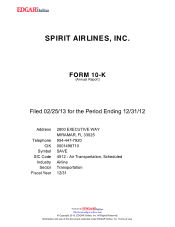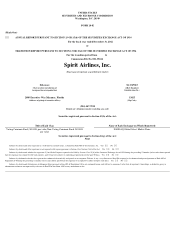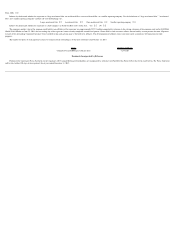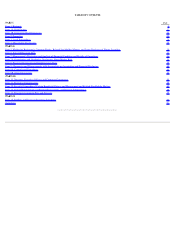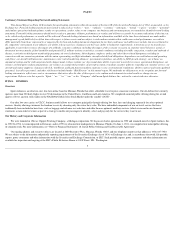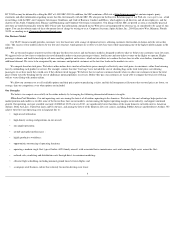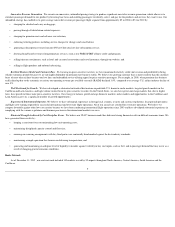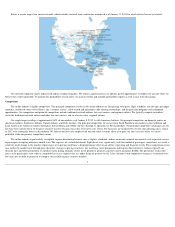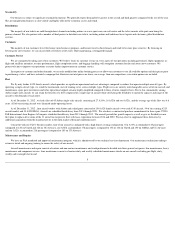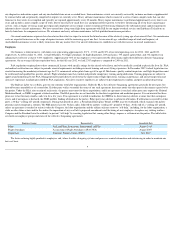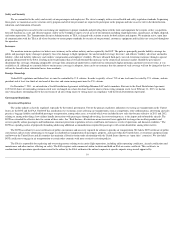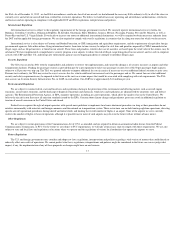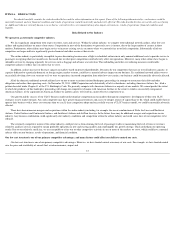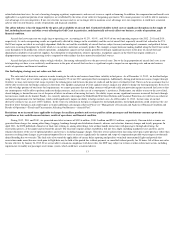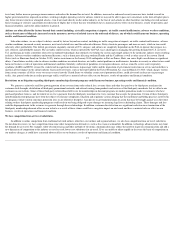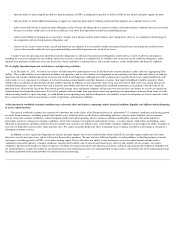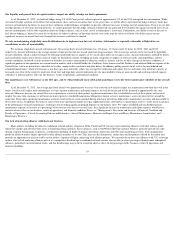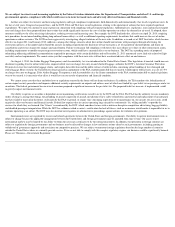Spirit Airlines 2012 Annual Report Download - page 10
Download and view the complete annual report
Please find page 10 of the 2012 Spirit Airlines annual report below. You can navigate through the pages in the report by either clicking on the pages listed below, or by using the keyword search tool below to find specific information within the annual report.
any diagnostics and routine repairs and any unscheduled items on an as needed basis. Line maintenance events are currently serviced by in-house mechanics supplemented
by contract labor and are primarily completed at airports we currently serve. Heavy airframe maintenance checks consist of a series of more complex tasks that can take
from one to four weeks to accomplish and typically are required approximately every 20 months. Heavy engine maintenance is performed approximately every four to six
years and includes a more complex scope of work. Due to our relatively small fleet size and projected fleet growth, we believe outsourcing all of our heavy maintenance
activity, such as engine servicing, major part repair and component service repairs is more economical. Outsourcing eliminates the substantial initial capital requirements
inherent in heavy aircraft maintenance. We have entered into a long-term flight hour agreement with IAE for our engine overhaul services and Lufthansa Technik on an
hour-by-hour basis for component services. We outsource our heavy airframe maintenance to FAA-qualified maintenance providers.
Our recent maintenance expenses have been lower than what we expect to incur in the future because of the relatively young age of our aircraft fleet. Our maintenance
costs are expected to increase as the scope of repairs increases with the increasing age of our fleet. As our aircraft age, scheduled scope of work and frequency of
unscheduled maintenance events is likely to increase like any mature fleet. Our aircraft utilization rate could decrease with the increase in aircraft maintenance.
Employees
Our business is labor intensive, with labor costs representing approximately 19.1% , 19.6% and 22.0% of our total operating costs for 2012 , 2011 and 2010 ,
respectively. As of December 31, 2012 , we had 680 pilots, 933 flight attendants, 24 flight dispatchers, 269 mechanics, 795 airport agents/other, and 332 employees in
administrative roles for a total of 3,033 employees. Approximately 54% of our employees were represented by labor unions under three different collective-bargaining
agreements. On an average full-time equivalent basis, for the full year 2012, we had 2,767 employees, compared to 2,456 in 2011.
FAA regulations require pilots to have commercial licenses with specific ratings for the aircraft to be flown, and to be medically certified as physically fit to fly. FAA
and medical certifications are subject to periodic renewal requirements including recurrent training and recent flying experience. In December 2007, federal legislation was
enacted increasing the mandatory retirement age for U.S. commercial airline pilots from age 60 to age 65. Mechanics, quality-control inspectors, and flight dispatchers must
be certificated and qualified for specific aircraft. Flight attendants must have initial and periodic competency training and qualification. Training programs are subject to
approval and monitoring by the FAA. Management personnel directly involved in the supervision of flight operations, training, maintenance, and aircraft inspection must
also meet experience standards prescribed by FAA regulations. All safety-sensitive employees are subject to pre-employment, random, and post-accident drug testing.
The Railway Labor Act, or RLA, governs our relations with labor organizations. Under the RLA, the collective bargaining agreements generally do not expire, but
instead become amendable as of a stated date. If either party wishes to modify the terms of any such agreement, they must notify the other party in the manner agreed to by
the parties. Under the RLA, after receipt of such notice, the parties must meet for direct negotiations, and if no agreement is reached, either party may request the National
Mediation Board, or NMB, to appoint a federal mediator. The RLA prescribes no set timetable for the direct negotiation and mediation process. It is not unusual for those
processes to last for many months, and even for a few years. If no agreement is reached in mediation, the NMB in its discretion may declare at some time that an impasse
exists, and if an impasse is declared, the NMB proffers binding arbitration to the parties. Either party may decline to submit to arbitration. If arbitration is rejected by either
party, a 30-day “cooling off” period commences. During that period (or after), a Presidential Emergency Board, or PEB, may be established, which examines the parties’
positions and recommends a solution. The PEB process lasts for 30 days and is followed by another “cooling off” period of 30 days. At the end of a “cooling off” period,
unless an agreement is reached or action is taken by Congress, the labor organization and the airline each may resort to “self-help,” including, for the labor organization, a
strike or other labor action, and for the airline, the imposition of any or all of its proposed amendments and the hiring of new employees to replace any striking workers.
Congress and the President have the authority to prevent “self-help” by enacting legislation that, among other things, imposes a settlement on the parties. The table below
sets forth our employee groups and status of the collective bargaining agreements.
We focus on hiring highly productive employees and, where feasible, designing systems and processes around automation and outsourcing in order to maintain our
low cost base.
9
Employee Groups
Representative Amendable Date
Pilots
Air Line Pilots Association, International (ALPA)
August 2015
Flight Attendants
Association of Flight Attendants (AFA-CWA)
August 2007
Dispatchers
Transport Workers Union (TWU)
July 2012

